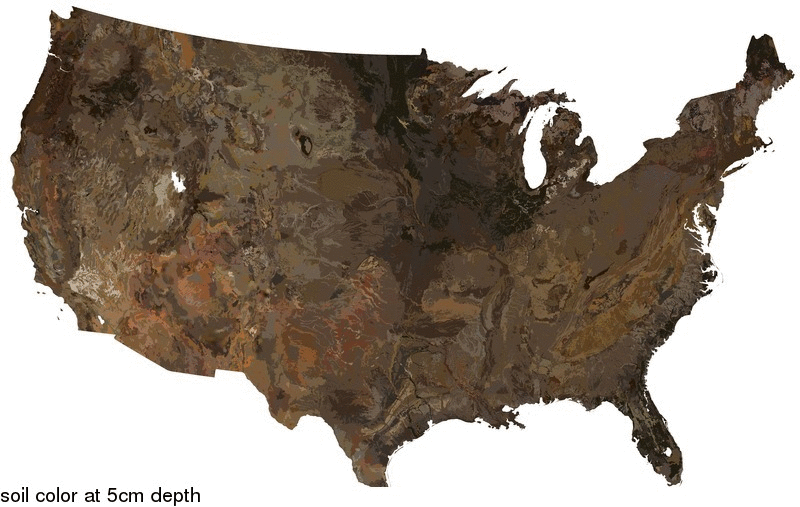Soil color is largely determined by it's composition.
There are three main components in soil:
- Gravel, sand, and silt. In essence, the type of stuff you find in sedimentary rocks. Usually, this is mostly silicate minerals like quartz, feldspar, and mica, and is usually pretty bland in terms of color. In theory, certain silt minerals (olivines for example) can produce greenish soils, though concentrations that high are generally uncommon. With sand involved, you can get lots of other colors (yellow, pink, purple, and even green), though this is usually only seen on beaches.
- Clay. Clay's often account for a large percentage of the weight of soil. They also usually account for many of the color variations. Most likely, that red soil near where you live has a lot of hematite rich clay in it. Clay's mostly contribute red, yellow, and brown shades to soil, but can in theory give almost any color. Brightly colored soils are usually the result of a sesquioxide clay, and can in theory be almost any color (red from iron, blue from copper or cobalt, green from copper, nickel, or chromium, yellow from chromium or iron, purple from manganese, etc), though only iron is particularly common.
- Humus. Humus is heavily decomposed organic matter. It has a rather distinctly dark brown (almost black) color to it, and also accounts for.much of the earthy smell of soil.
Beyond those, there are a few other things that may be in soil and impact the color:
- Charcoal. Usually found only in certain climates (warm with lots of humidity, like tropical rainforests), gives a very dark color to the soil.
- Fungus. There's a lot of fungus in soil. Usually, it's not concentrated enough (or colorful enough) to have an impact, but in places where there is a very high concentration, it can have a localized impact on soil color.
- Shells. Either from diatoms (that's what diatomaceous earth is, lots and lots of microscopic shells), or very finely ground shells from bigger organisms. You've probably seen pictures of pink or salmon colored beaches, the same effect can also happen to a much lesser degree in soil too. Usually though, lots of shells just turns soil white.
So, what color would that translate to on average? Well, for topsoil, due to the generally high humus content, probably a rather dark brown. Averaging over all soil, most likely something significantly lighter, as deeper soil tends to have much lower concentrations of organic matter, but likely still tan or beige.





